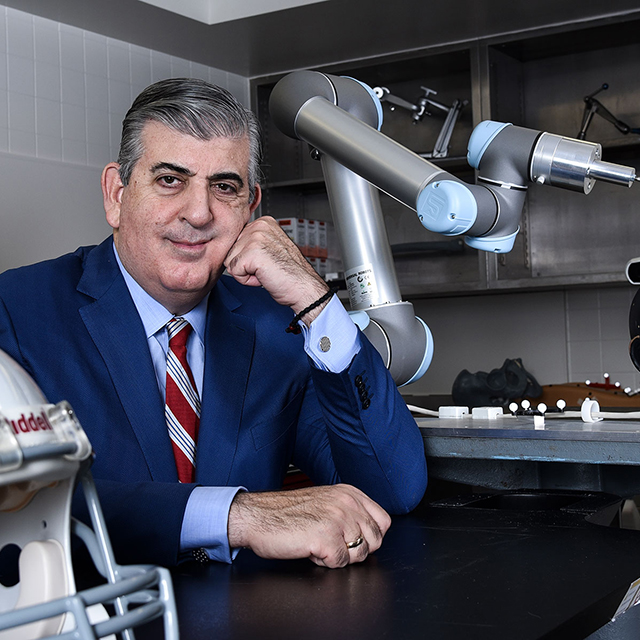The dazzling statistics of Ravens quarterback Lamar Jackson made National Football League history this season. Less heralded are statistics showing fewer concussions and other game-related injuries due to enhanced and enforced NFL safety rules, according to Nicholas Theodore, an expert in brain and spinal cord injuries and director of the Johns Hopkins Neurosurgical Spine Center.
Last year, the league announced there were 135 documented concussions in the 2018 regular season, down from 190 the previous year. Including injuries that occurred during the preseason, concussions fell from 281 to 214, a 23.8% decrease.
Theodore has been chairman of the NFL’s innovative Head, Neck and Spine Committee since 2018.
“With ongoing training, better helmets, new rules, more eyes on the field and constant reevaluation of the [NFL’s] concussion protocol, this year’s Super Bowl should be the safest ever,” Theodore says.
Dome asked the Johns Hopkins neurosurgeon to provide an update on his committee’s work and its impact on gridiron safety — not just in the NFL, but on school athletic fields, too.
Q. The New York Times recently published a story about a Stanford bioengineer — and former football player — who is trying to design a concussion-resistant helmet. What do you think about that?
A. There is no doubt that better helmet design can mitigate the effects of blows to the head. In the NFL, each helmet used in professional football undergoes extensive biomechanical testing. The helmets are rated green for excellent protection, yellow for good protection and red for poor protection. There has been a significant effort with the NFL and the NFL Players Association to migrate players into better performing helmets. This has been very successful. The proof that better helmets work is the fact that those players outfitted with the best-performing, green helmets had the lowest number of concussions. There is no doubt that as technology improves, we can decrease the severity and number of concussions.
Q. What’s the latest on your research for the NFL?
A. We continue to focus on every aspect of making the game safer. We have medical data, testing, imaging, and video footage of every game to evaluate exactly what happened at the time of any injury. Rarely in trauma do we have high-resolution video of an injury from multiple vantage points. All of this data is continuously analyzed by high-level statisticians and analytics experts so that we can find trends in injuries and suggest strategies that may decrease the number of concussions and other injuries.
Q. Last year’s Super Bowl was the first to enforce the 2018 use of helmet rule that declares a foul if a player lowers his head to initiate and make contact with his helmet against an opponent. Such a move triggers a 15-yard penalty and possible ejection from the game. Your committee created that rule. How has it affected the game?
A. Overall, the biggest contributor to concussions is head-to-head contact. While some players did not get the memo on the use of helmet rule, it hopefully will change their behavior.
Other changes include heightened observation during games. At this point, there are three unaffiliated neurotrauma consultants — UNCs — on the field at each game. UNCs are mostly neurosurgeons but can be neurologists or sports medicine/ER physicians who have special interest and experience with concussion and game-day injuries.
There is one UNC on each sideline and one in an observation booth watching a video feed — our “eye in the sky.” A certified athletic trainer also observes video. These individuals can communicate with each other in real time to pull any player with a suspected concussion out of the game to get evaluated.
Q. Do parents ask you whether they should allow their kids to play football? Do you see your work with concussion prevention influencing other sports — say, lacrosse?
A. Parents always ask me whether or not their children should play contact sports. My answer always is, “Yes!” — as long as proper precautions are taken and there is an awareness regarding what a concussion is and what to do when it happens: Stop play, get evaluated and get cleared prior to returning to play. Along with football, lacrosse and soccer are also sports that have a risk of concussion. The same tenets apply to them.
The positive benefits of team sports for our youth cannot be overstated. Life lessons in leadership, teamwork and sportsmanship, as well as the health benefits of decreased obesity and better strength and cardiovascular health, are all critical factors that need to be considered.

